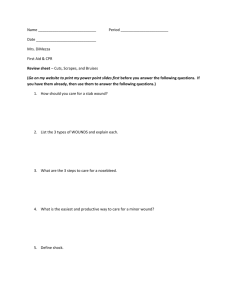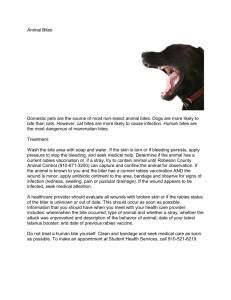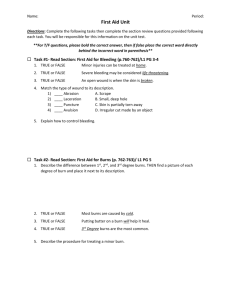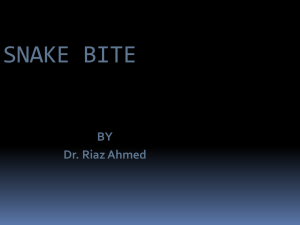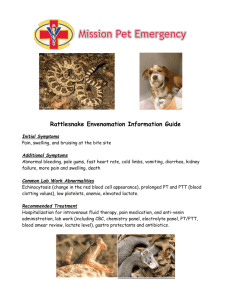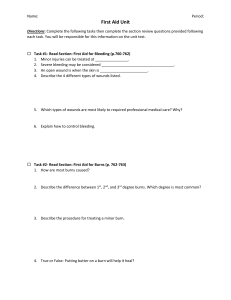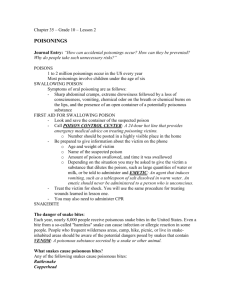Tamara Baird - Lipscomb University
advertisement
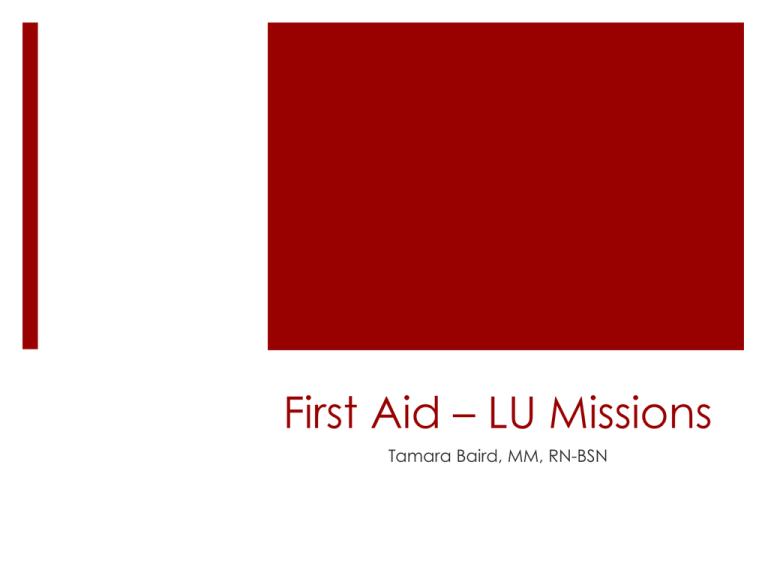
First Aid – LU Missions Tamara Baird, MM, RN-BSN When on the field….you need to take care of yourself Ideas to think about and discuss with your teams Jet lag Avoid blood clots on long flights Dehydration vs caffeine levels Protection from insects and critters Altitude sickness Signs/symptoms of a head injury Heat stroke Basic first aid How to avoid jet lag during travel Avoid large meals, alcohol and caffeine Drink plenty of water Move around the plane to promote mental/physical acuity Wear comfortable shoes and clothing – Compression Socks Sleep Medication…if you have a cold/ear ache/sinus pressure during flights...please bring water with you on the plane and keep hydrated Diabetes/Asthma and travel Depending on the number of time zones crossed, people with diabetes may need to adjust their insulin schedule during travel and arrival at their destination. Team leaders should know if these needs exist and plan for them. Make sure the team members take their inhalers in their carry on Compression socks http://www.compressionstockings.com Heat Cramps First warning of heat exhaustion &occur in the muscles which are doing most work: arms, legs, and abdomen. Usually due to the lack of body salt (because of sweating) Symptoms: Shallow breathing, vomiting, dizziness Treatment: Move to shade. Rest. Drink water with a little salt dissolved in it – only a pinch to a halfliter or pint. Hot climates: Heat Stroke Most serious result of overexposure to the sun Symptoms: hot dry skin, face flushed and feverish – but sweating STOPS Temperature rises, pulse becomes fast and strong. Severe headache often with vomiting Treatment: lay in shade, head and shoulders slightly raised. Remover out clothing and cool body with a cloth of TEPID water. Do not immerse in water SHOCK Shock is a very serious situation & one in which can be recognized and treated on the field. S/Sx of shock: State of collapse, extreme pallor, cold & sweaty skin, feeble but rapid pulse and excitement/apprehension Nervous system: shock produces an acute slowing of the heart with a drop in blood pressure. Pain/excessive nerve damage are the cause. Blood loss: delayed shock may happen a few minutes to hours after an injury. Treatment for SHOCK Lay the patient flat and elevate the legs. Loosen tight/restrictive clothing around the neck, chest or abdomen. Rest and reassure. Never LEAVE a shock victim. Do NOT give liquids. Maintain body heat but do not add heat – warming the surface of the body will draw blood away from the internal organs which need it most. Stand by to give mouth-to-mouth BITES from all God’s Creatures Bites from snakes, spiders, and bee stings essentially have the same treatment plan. Bites = Venom = Poison Goal: to prevent poison spreading through the body. Make the patient relax, resting with the bitten area lower than the heart. Wash away any venom on the surface of the skin with soap if possible. Place a RESTRICTIVE BANDAGE ABOVE THE BITE – not a tourniquet and a bandage down over the bite. This is to prevent the poison from spreading rapidly and from entering the lymph system. BITES from all God’s Creatures Place wound in cool water – a stream. Keep it as cool as possible. NEVER cut a snake bite or try to suck out the poison. Spider bites – treat the same way as snake bite. Keep the wound cool. Bee Stings – are to be left in the skin. Do not squeeze the stinger end or more venom will be injected. If you have a needle handy – you can stroke the stinger with the side of the needle. Treatment is again like that for a snake bite. VICK’S...for those critters that you can’t see General Poisoning If something has been swallowed which you believe to be dangerous (potential poisoning substance) ask the patient to vomit. Universal antidote – vomit plus activated charcoal Tablets from Health Food store Cold Climates - Hypothermia Prolonged exposure to cold. Body can’t generate heat as fast as it looses heat and its temperature falls below normal. Caused by exposure to wind, rain and low temperatures. Also brought on by: exhaustion, inadequate clothing, shelter an food intake, lack of knowledge and preparation S/Sx: irrational behavior, slowing down of responses, failing to respond to questions/instructions, sudden uncontrolled fits of shivering, loos of coordination, stumbling and falling TX: prevent further heat loss, remove wet clothing, warm pt by laying beside them, give warm fluids and sugary foods only if conscious First Aid Items (Call home ) Toilet seat liners Flashlight with new batteries Mosquito net Vick’s Duck Tape (for when your luggage explodes) Masks- to cover nose Hand sanitizer/disposable wipes Peppermints – Tums – Imodium A-D First Aid Items (Call home ) Benadryl – for severe allergic reactions Aspirin/Tylenol Bandaids/Neosporin Water purifying tablets/ water bottle http://www.potableaqua.com - Potable Aqua Gatorade dry powder – to mix in water bottle Motion sickness pills/patch – Walmart – MotionEase Motion Sickness - $12.77 Sleeping pills Eye drops/nasal spray/cough drops CDC & First Aid Kits http://wwwnc.cdc.gov/travel/destinations/list Two kits to demo First Aid course book Face masks for CPR Thank you and God bless! Great Book for More Info References www.compressionstockings.com http://wwwnc.cdc.gov/travel/destinations/list http://www.amazon.com/SAS-SurvivalHandbook-RevisedSituation/dp/0061733199/ref=sr_1_1?s=books&ie= UTF8&qid=1392657929&sr=11&keywords=sas+survival+handbook http://www.potableaqua.com

